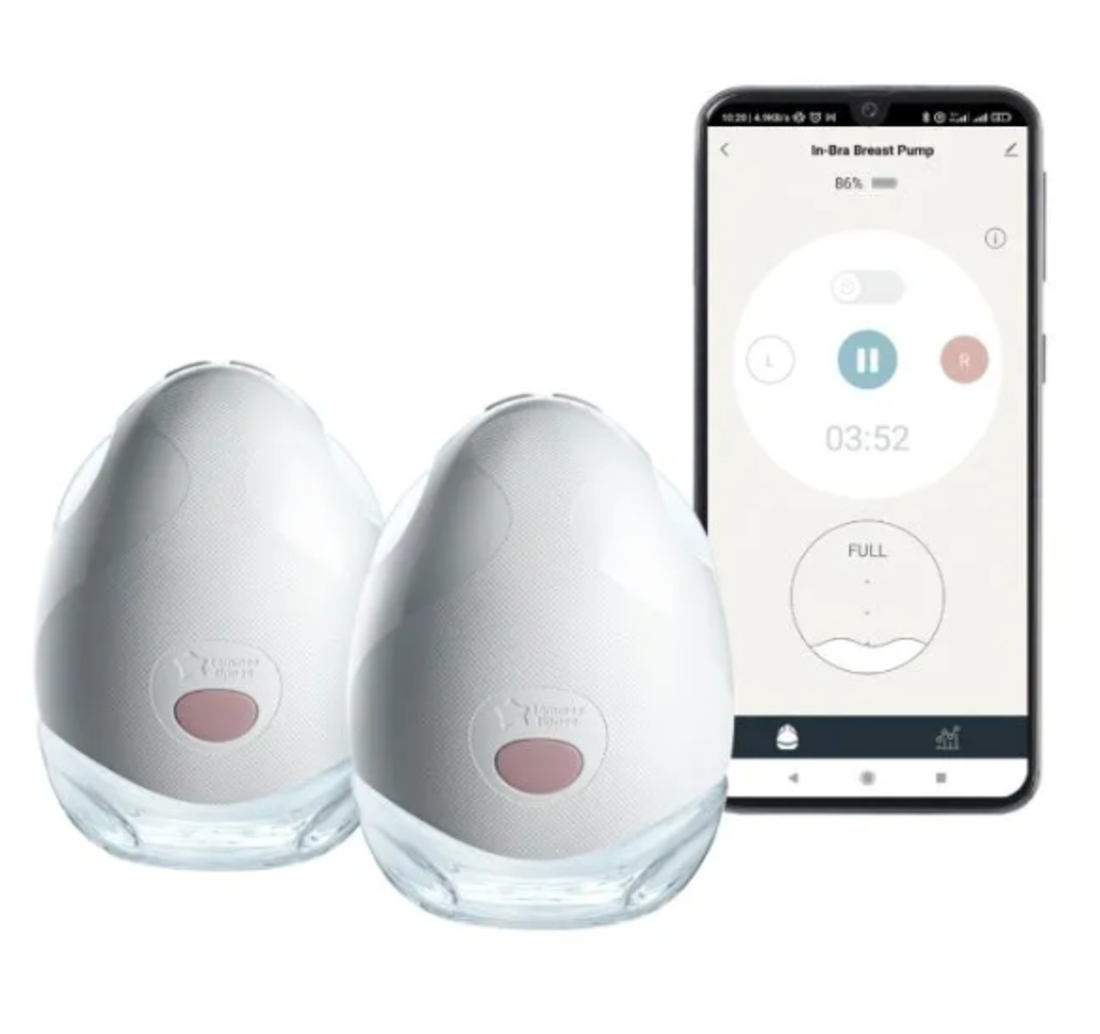
Breastfeeding is an experience that looks different for every mom. Some of us feed only at the breast. Some are exclusive pumpers. Others breastfeed their babies for a few months, some for a few years. Some of us combo feed and others supplement with breast milk. Some nurse on demand and others prefer to stick to a nursing schedule or routine. Whatever choices a nursing mom makes are hers to make.
One thing that's the same for pretty much all of us, though, is that it can take some time to figure things out. One of those things is learning how to properly, efficiently, and comfortably express breast milk, whether you are pumping full-time or just pumping to have some milk available when you're away from your baby. Breast pumps can be intimidating. So this National Breastfeeding Month, CafeMom decided to chat to Jessica Anderson, an International Board Certified Lactation Consultant (IBCLC), breast pump expert, and partner with feeding brand Tommee Tippee. She gave us her top tips for using a breast pump to express milk.
"It really is not as natural as people expect it to be," Anderson says of breastfeeding, noting that pumping breast milk can be surprisingly challenging for many moms. "But it is something that any parent can learn how to do."
More from CafeMom: 12 Tips To Make the Transition to Breastfeeding Easier
Pumping Considerations
There are nearly as many scenarios as there are moms and babies. Basically, any mom that wants to feed her baby human milk should consider using a breast pump at some point. It's one more tool in the arsenal to use to help establish a successful breastfeeding relationship and meet your feeding goals.
"We use a pump to help support the parent's goals," says Anderson. "Anytime a mom wants to feed human milk and the baby is not latching, is not available to latch. It's the time, say mom's at work, mom and baby are separated, or if baby is not latching well."
Even if you plan to nurse your baby full time, situations may come up that require you to use a pump to foster the breastfeeding relationship, so it's a good idea to familiarize yourself with your options and how to use one. And of course, if you choose to pump exclusively or will need to pump throughout the day while you're at work, learning a bit about the process and how to do it most effectively will be a big help.
"There's really no right or wrong circumstance as long as it's supporting the parent's goals," Anderson says.
Expect a Learning Curve
Just like with nursing your baby at the breast, there can be a bit of a learning curve when it comes to using a breast pump. Neither is as intuitive as many would think.
"What I hear time and time again is that moms are so surprised that it's not as simple as just putting the pump to the breast and having milk flow," Anderson explains. "They have to learn to work with this device. How to work with your body and then, often there's a little bit of customization of the flange fit and your suction level, the speeds to help you find that sweet spot for your body."
That might sound a bit overwhelming. Devices? Suction level? What's a flange?
Don't worry, we've got you covered.
More from CafeMom: 34 Surprising Things Moms Can Do With Their Breast Milk
Choosing a Pump

First things first: You'll need to choose a breast pump. In fact, you might purchase more than one, depending on your lifestyle and individual needs. You may also find that you need to try out a few before you find the one that works best for you and your baby.
"Think about your lifestyle and what's gonna work for you," the Tommee Tippee pump expert tells us. "A lot of people like to put rules about like, 'You need to have a pump that's hospital grade or you need to only use your wearable once or twice a day.' My thing is that moms don't exist in a vacuum and that all these rules are great, but we've gotta pick what's gonna work for you and your lifestyle or you're simply not gonna pump."
Go to the store and check out a few different models in person. Talk to moms with similar lifestyles and breastfeeding goals as yours and get recommendations. You can even call an IBCLC and discuss your needs and preferences ahead of time and get some suggestions from a professional.
Flange Fit
The fit of your breast pump flanges is one of the most important factors when it comes to successfully expressing breast milk. Pumps like the Tommee Tippee Made for Me Wearable Pump and other premium breast pumps, typically come with a few different flange sizes, but others can be ordered separately. Tommee Tippee actually allows moms to order the right size for free if it's not one of the two included with their breast pump.
It's important to make sure that the flanges fit your body properly for a number of reasons, including that you will be able to express the most amount of milk if your flanges are sized correctly.
"What I find consistently across thousands of moms that I've been able to help is that about 40% are really struggling with measuring the nipple because we're looking for a very specific anatomical landmark when we're measuring a nipple and they struggle to find that," Anderson says. "Most moms are kind of embarrassed that they're struggling with that. It's a weird thing to even have to know, but it's so crucial to being able to get that flange fit because we're looking to try to keep as much of that areola out of the tunnel as possible to prevent damage and prevent blocking the milk flow."
Measurements Matter
How exactly do you measure a nipple? Well, you measure the diameter of just the nipple, not the areola, and the measurement you get in millimeters will correspond to the flange size, which is typically between 17mm and 24mm, but can also be larger or smaller.
"We need to measure in millimeters and we need to measure before pumping," Anderson explains. "If you measure after you've been using a flange, that may be somewhat the wrong size on elastic tissue [because] the tissue swells and you're really just measuring your capacity to swell, which is the opposite of what we want to do."
Suction Surprise
"Most people think that for suction, if you turn the suction all the way up it will suck more milk out like a straw. That's just not how it works," Anderson says.
Suction level can affect efficiency. "Typically, what we find is that the lower to mid-range suction is actually better and what I have moms do is start low and we turn it up based on 'Can you feel that nice gentle tug on the nipple like you should feel when you're nursing?'"
Consistency Wins
"We need to pump regularly. The breast is not intended to hold milk for long periods of time, and even though it can act as a storage vessel for milk for hours on end, that typically reduces the supply … We get better results when we pump regularly with a pump that is working really well," Anderson tells CafeMom. The best way to increase your efficiency when pumping breast milk is to be consistent and make it a routine.
You should still use your breast pump regularly even if you aren't exclusively pumping. "Once or twice a day we need to pull that pump out. Our bodies learn very quickly in the initial postpartum period what is expected in terms of milk production and we have to keep that consistent in order to support the milk supply goal," Anderson suggests.
So, if you want extra breast milk for a freezer stash, you need to pump an extra session every day so that your body will know to expect it and be conditioned to respond to the pump. Even if you think that you'll only need expressed breast milk occasionally, it's still a good idea to pump once a day at the same time each day so that your body is familiar with the breast pump and does what it's supposed to do.
Manage Expectations

Many moms have skewed expectations when it comes to not only breast milk production, but also how much breast milk they'll be able to express during each pump session.
"The average mom is producing between 24 to 36 [ounces a day], with 36 being the highest. I would say 24 to 30 is more the normal amount of milk that a baby is taking in at the breast, so for a breastfeeding mom, 2 to 3 ounces in a pump session may actually be exactly what their baby is taking at the breast," Anderson explains.
That doesn't mean that you will get that amount every pump session and if you are pumping in between feeds at the breast, you will likely get less. That's normal and it's OK to combine milk from different pump sessions to get a full 2- to 4-ounce bottle when you are using it to supplement or to feed when you are away from baby. Again, that 24 to 36 ounces might be what a mom exclusively pumps is able to get in 24 hours, not a mom who is also nursing at the breast.
"Most moms are surprised to find that you can feed a baby and have them growing really happy and chunky with rolls galore and never see more than 3 ounces of milk," Anderson says.
Don't Stress!
Lots of moms who have successfully breastfed their babies can tell you that it can be stressful. Even when mom and baby are physically doing well, the demands of breastfeeding can feel overwhelming. Try not to let it get to you. These days there are tons of resources and new technologies out there to help make it easier and minimize the stress.
For example, things like the "Constant Comfort" technology used by Tommee Tippee can be a game changer for many moms. "Pumping used to be going to sit down for 20 to 30 minutes with your gigantic wall pump that's loud and flanges hanging off of you," Anderson says. "It makes it really hard to add that in on top of everything else that motherhood and parenthood demand of you. This new pump technology makes it so you can add pumping in almost in the background. Pumping doesn't have to be your ball and chain."
Get Help
And if you are feeling stressed and overwhelmed about pumping or breastfeeding in general, find an IBCLC consultant. Get help. There is really no question or problem that is too big or too small, and most health insurance plans will cover a certain number of visits.
"If things are not going splendidly, you wanna get a pumping expert lactation consultant to help you out. Moms are so scared to reach out for help sometimes with pumping because they feel like it should be simple and they're missing out on this opportunity to really make pumping work for them when you're working with an expert who knows all the options," Anderson says.




